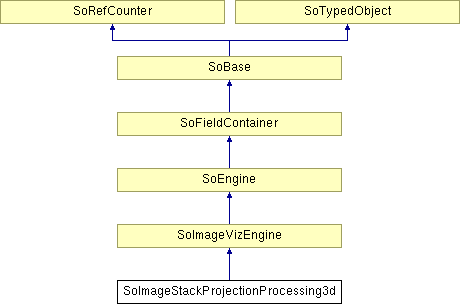SoImageStackProjectionProcessing3d Class Reference
[Stack Operations]
 SoImageStackProjectionProcessing3d engine
More...
SoImageStackProjectionProcessing3d engine
More...
#include <ImageViz/Engines/ImageManipulation/StackOperations/SoImageStackProjectionProcessing3d.h>

Public Types | |
| enum | ProjectionMode { INTENSITY_MAXIMA = 0, GRADIENT_MAXIMA = 1, PROJECTION = 2, INTENSITY_MINIMA = 3, MEDIAN = 4, MEAN = 5, VARIANCE = 6, ENTROPY = 7, ENERGY = 8 } |
| enum | GradientOperator { GAUSSIAN_GRADIENT = 0, MORPHOLOGICAL_GRADIENT = 1, RECURSIVE_GRADIENT = 2 } |
Public Member Functions | |
| SoImageStackProjectionProcessing3d () | |
Public Attributes | |
| SoSFImageDataAdapter | inImage |
| SoSFEnum | projectionMode |
| SoSFInt32 | smoothingSize |
| SoSFEnum | gradientOperator |
| SoImageVizEngineOutput < SoSFImageDataAdapter, SoImageDataAdapter * > | outImage |
| SoImageVizEngineOutput < SoSFImageDataAdapter, SoImageDataAdapter * > | outLabelImage |
Detailed Description
 SoImageStackProjectionProcessing3d engine
SoImageStackProjectionProcessing3d engine
The SoImageStackProjectionProcessing3d engine creates a single image containing selected pixels from a stack of input images.
For example, when you make several acquisitions of the same object with different acquisition conditions, the images you get may not have the same focused areas. The SoImageStackProjectionProcessing3d engine examines all the images to get the best values of the sequence and build the resulting image.
When projectionMode is one of INTENSITY_MAXIMA, GRADIENT_MAXIMA or INTENSITY_MINIMA, the engine also generates an outLabelImage that shows the contribution source (i.e. the sequence number of the image from the input stack) on the result image outImage.
This engine can produce higher quality results than using the standard Maximum/Minimum Intensity Projection (MIP) rendering in VolumeViz.
For color images, it works in the HSL color space and uses only the lightness.
SEE ALSO
SoGradientOperatorProcessing2d
FILE FORMAT/DEFAULT
- ImageStackProjectionProcessing3d {
| inImage | NULL |
| projectionMode | GRADIENT_MAXIMA |
| smoothingSize | 5 |
| gradientOperator | MORPHOLOGICAL_GRADIENT |
Library references: zstack
Member Enumeration Documentation
- Enumerator:
GAUSSIAN_GRADIENT Compute a gaussian gradient (convolution with derivatives of gaussian function along the stack direction).
MORPHOLOGICAL_GRADIENT Compute a morphological gradient (see SoMorphologicalGradientProcessing for definition).
RECURSIVE_GRADIENT Compute a recursive gradient (Canny-Deriche on stack direction).
- Enumerator:
INTENSITY_MAXIMA Select the pixel with the highest value of the sequence.
GRADIENT_MAXIMA Select the pixel with the highest gradient.
This mode enables the gradientOperator field.
PROJECTION Sum all values of the sequence.
INTENSITY_MINIMA Select the pixel with the lowest value of the sequence.
MEDIAN Select the pixel which is the median of the sequence.
MEAN Compute the average of the sequence.
VARIANCE Compute the variance of the sequence.
ENTROPY Compute the entropy of the sequence based on this formula:
![\[Entropy= -\sum_{i \in seq} {P(x_i)*log(P(x_i))}\]](form_523.png)
where
 is the probability to have a pixel with value
is the probability to have a pixel with value  (it's the number of those pixels divided by the total number of pixels).
(it's the number of those pixels divided by the total number of pixels). ENERGY Compute the energy of the sequence based on this formula:
![\[Energy= \sum_{i \in seq} {P(x_i)^2}\]](form_526.png)
.
Constructor & Destructor Documentation
| SoImageStackProjectionProcessing3d::SoImageStackProjectionProcessing3d | ( | ) |
Constructor.
Member Data Documentation
The type of process.
Use enum GradientOperator. Default is MORPHOLOGICAL_GRADIENT
A 3d volume representing a stack of 2d images.
Default value is NULL. Supported types include: grayscale binary label image.
| SoImageVizEngineOutput<SoSFImageDataAdapter,SoImageDataAdapter*> SoImageStackProjectionProcessing3d::outImage |
The output image.
Default value is NULL. Supported types include: grayscale binary label color image.
| SoImageVizEngineOutput<SoSFImageDataAdapter,SoImageDataAdapter*> SoImageStackProjectionProcessing3d::outLabelImage |
The output map label image.
Each label represents the z plane used in output image. Default value is NULL. Supported types include: label image.
The type of process.
Use enum ProjectionMode. Default is GRADIENT_MAXIMA
The size for the smooth process.
Default value is 5.
The documentation for this class was generated from the following file:
- ImageViz/Engines/ImageManipulation/StackOperations/SoImageStackProjectionProcessing3d.h